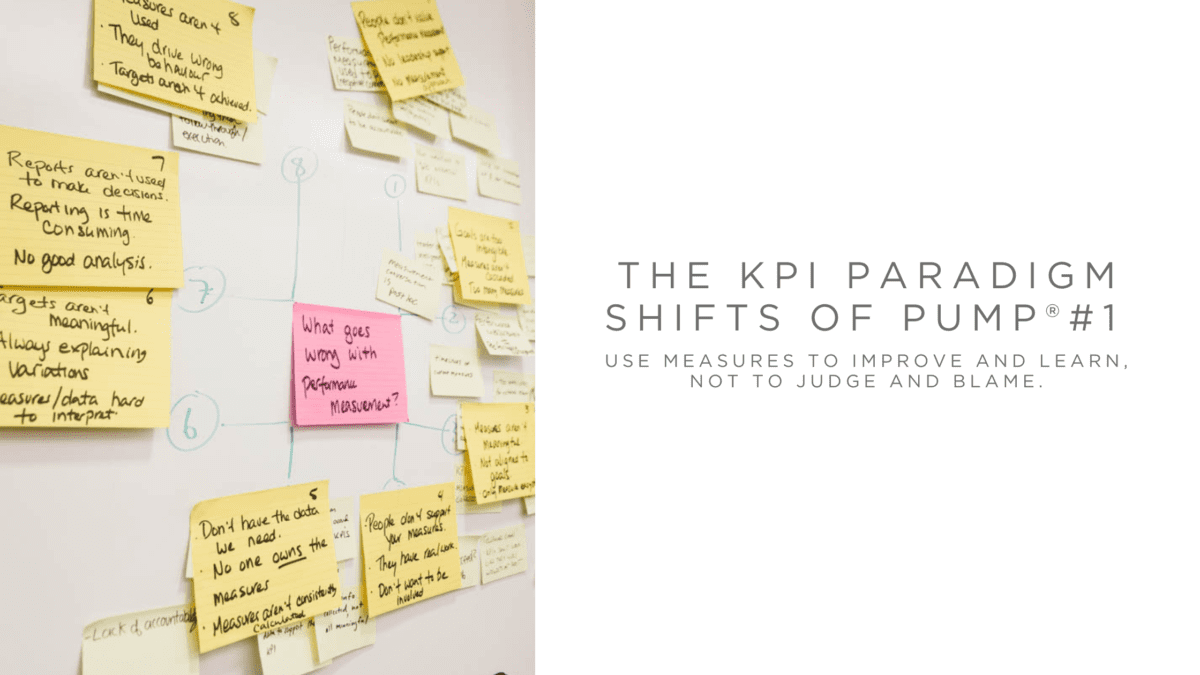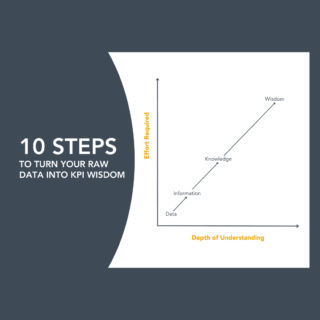The KPI paradigm shifts of PuMP® series is about five of the many ways that Stacey Barr’s Performance Measurement framework (known as the PuMP Blueprint) helps us change our level-of-thinking about performance measurement so we can truly align teams to our organization’s strategic direction and drive more successful strategy implementation. The idea was inspired by the Paper published by the United Nations Economic Commission for Europe; and it’s about how they used PuMP to measure the value of official statistics and the paradigm shifts they experienced while using the PuMP KPI approach.
When it comes to performance measurement (aka, metrics, KPIs, indicators etc.) in the workplace, people-leaders often think about data, reports, software tools and other technical aspects of measurement first. But beware of this initial thinking…
How employees believe performance measurement will be used in the workplace fundamentally affects whether our organization’s performance will improve or not. Generally, we see the use of measurement fall into these two buckets:
- We use them to empower and improve how our team, department or organization performs
- We use them to judge (punish, blame, prod, or reward) our people.
Your chosen approach for measurement determines everything that comes after so be mindful of the paradigm you currently have in your workplace.
The most commonly held paradigm is to focus on using measures to judge our people by looking for who or what to blame when performance isn’t good enough, or conversely, to use it to reward an individual’s efforts.
Let’s explore what behaviour this current paradigm is truly driving?
When leaders use measurement for reward, they think it will drive the behaviours they want more of; but they fail to recognize that it more likely drives the opposite. Let’s explore where your organization’s performance culture currently sits.
Do you recognize these behaviours?
- People collude to game or manipulate the measure’s data so it “looks better.”
- People focus on “quick fixes” with trivial measures that make it easy to “hit targets.”
- Individuals start “looking out for number #1”, diminishing the teamwork needed for successful strategy execution.
If these behaviours look familiar, you are likely in a culture where measures are used for punishing and rewarding individuals and the true purpose of performance measurement has been forgotten.
Would you rather see these behaviours?
- We let our measures reveal what isn’t performing well enough so we can focus our efforts where they are needed most now.
- We act on the information provided by our measures by looking into the root cause holding performance back from improving.
- We monitor our measures to look for statistically-sound signals of change over time to make sure performance is improving as expected from our investments.
- We honestly and accurately celebrate our wins.
When we shift our measurement paradigm and start to focus on using measures to drive improvement, we live in a new-found curious state of learning and continuous improvement, and our culture shifts to a place where people are excited to use measures for decision-making.
Wondering if your organization is stuck in using measurement for blame or reward? Check-out these symptoms
Symptom #1: KPIs are used to directly measure an individual’s performance.
We will recognize this symptom when quantified measurement becomes our employees’ enemy, and they do everything they can to avoid and discount the measures that are part of their individual “personal performance plans”. They feel that their worth is reduced to a few numbers, and to make matters worse, the numbers used to measure them are frequently:
- outside their individual control to change and improve,
- trivial in nature and pull their focus away from more important strategic priorities.
Symptom #2: People-leaders use KPIs to “manage” their staff, not the work itself.
You will recognize this symptom when KPIs feel like rods for people’s backs, meaning that someone above them is using the KPIs to poke, prod and shame individuals into better performance. Often, these managers lack the know-how to encourage their employees to look for underlying root causes in the way the work is being done (within the business process and workflows), which is more likely to be the culprit holding performance improvement back, rather than any individual employee.
Symptom #3: Leaders, managers and employees are held accountable for “hitting targets.”
You will recognize this symptom when leaders, managers and employees will only do what’s needed to quickly “hit a target”. This is also known as “metric fixation” (a term used by Jerry Muller in his book The Tyranny of Metrics). You will notice how people manipulate data, use vanity metrics, or take shortcuts just to hit those targets and get the reward associated with it (even though it’s likely only a temporary “hit”).
Wondering what might be different when your organization begins to shift the measurement paradigm?
When measures are used to continuously learn and improve, you will witness employees exhibiting these behaviours:
- Requesting time and new capabilities to meaningfully measure the outcomes of their work.
- Seeking more reliable data linked directly to what matters most.
- Asking for reports that accurately provide insights from measures that leaders and teams can act on.
- Becoming more focused on the strategy that matters most as the whirlwind of “activity for activities-sake” begins to quiet.
Ready to start shifting the paradigm for a better measurement culture within your organization?
Three Questions to Trigger Conversations and Inspire Change
Question #1: Do we believe that an individual employee can drive how our organization performs?
- Isn’t it more common for people to work in teams to achieve a strategic goal?
- What have you noticed when individual employees are measured alone?
- How can we do this better?
Question #2: Are we routinely getting larger and sustained performance improvements in our organization and teams, or are we more likely to get bursts of improvement that seem short‐lived?
- How do we choose actions when trying to improve performance?
- Do you think we might get better results if we explore how the work is getting done (process improvement or the steps in our workflows) and look for root causes, beyond the people?
- Do we need to build more capabilities for root cause and process thinking?
Question #3: What’s more important to us, hitting targets temporarily (a moment in time) or learning how to continually make performance better (sustained over time)?
- What do our current data visualizations show us (are they useful and usable insights)?
- How are we setting targets? When one point of data hits the chosen target, do we celebrate? How do we feel when the next data point misses the target? What conclusions are we drawing from this pattern?
- Have we ever experienced the manipulation of data that makes performance look like we hit target? Why do you think we do this?
- Each of these questions is about trying to put a spotlight on bad assumptions that our current organizational cultures have taken for granted. There’s no doubt that it’s hard to turn people into Truth Seekers (evidence‐based decision makers) in a culture that is so driven by short term achievement, but we must start somewhere!
Where are you going to start?
More in this series:
- Early April: Paradigm Shift #2: Measures monitor results, not activity.
- Mid-April: Paradigm Shift #3: Measures come from evidence, not data.
- May: Paradigm Shift #4: Alignment of your teams to strategy is cause-effect, not copy-paste.
- Early June: Paradigm Shift #5: Measurement processes must be built-in, not bolted-on.



